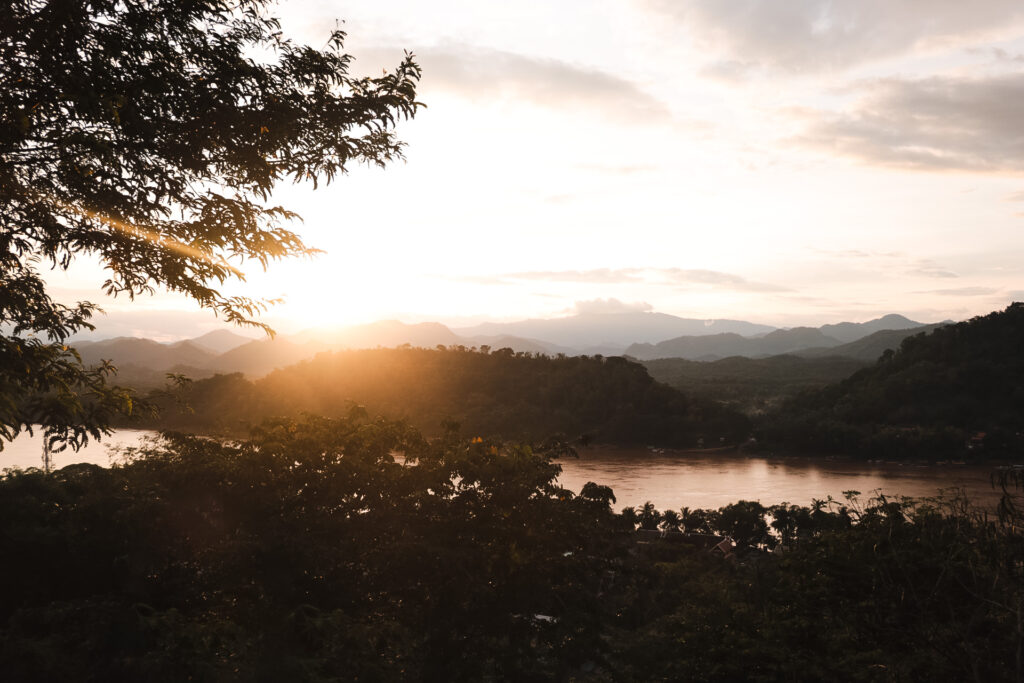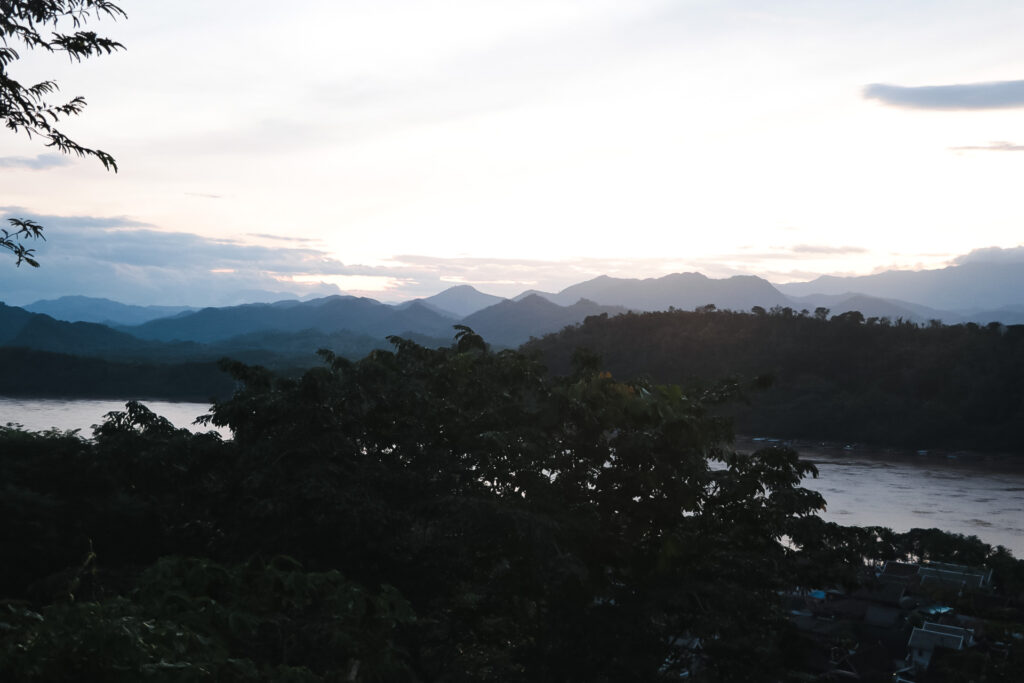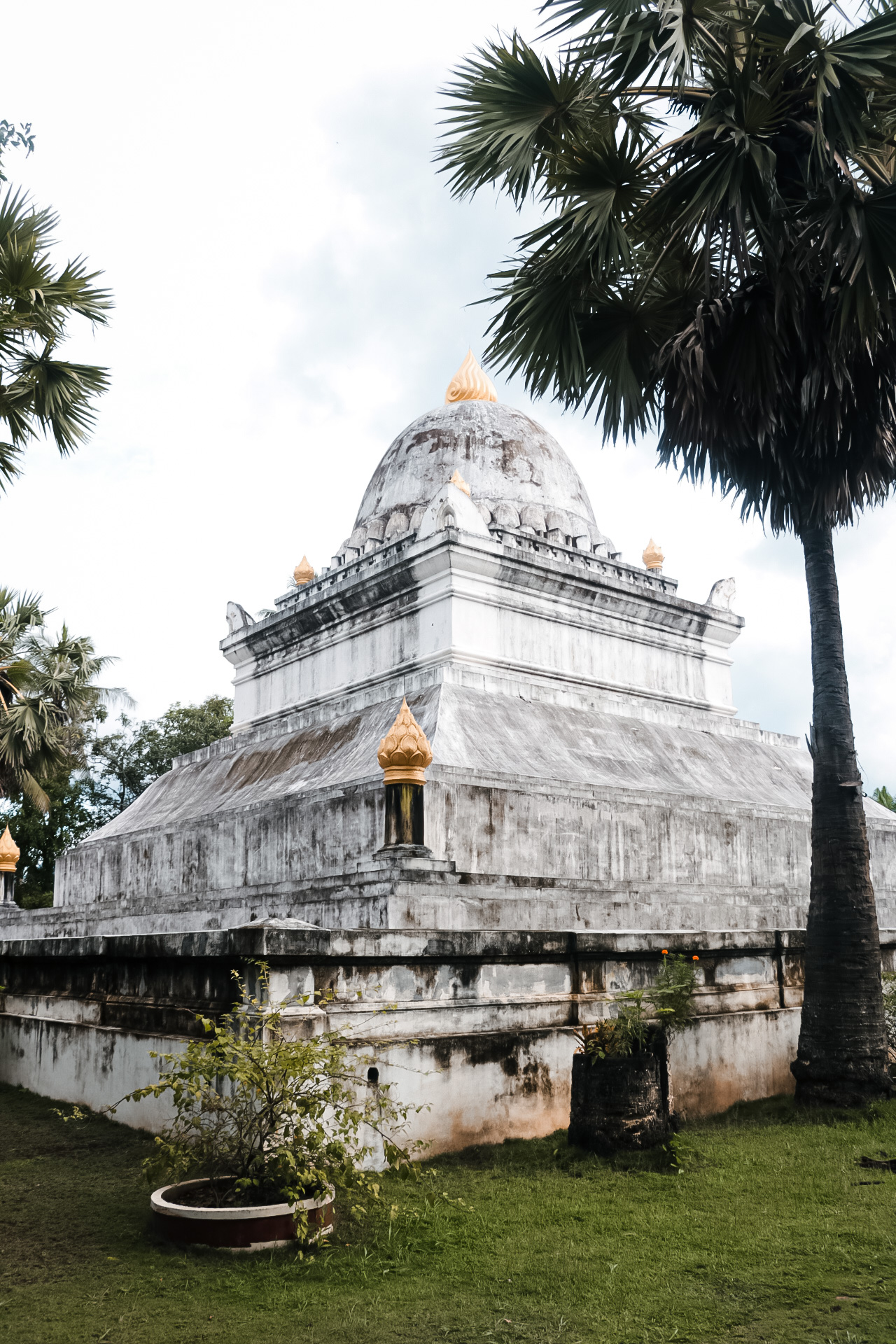The town Luang Prabang with the French influence – Laos Travel Diary
Next stop: Luang Prabang
After five nights in Vang Vieng, I finally went on to Luang Prabang. Since my train wasn’t until 12 pm, I decided to go to the gym before. It rained heavily again all morning. So I later had breakfast at the hostel because I didn’t want to walk to a restaurant in the rain. The food in the hostel was comparatively quite expensive, but very good.
After the breakfast I checked out and waited at the reception. Three boys were also waiting there as they were also on their way to Luang Prabang. It also turned out that we would all be in the same hostel there. For me it was a little more relaxed knowing that I didn’t have to take the train ride alone.
Taking the train to Luang Prabang
From Vang Vieng to Luang Prabang you can either take several hours by bus or an hour by train. Since an hour on a train is much more pleasant than sitting in a crowded van and driving over bumpy roads for hours, everyone decides to take the train to Luang Prabang.
Shortly after eleven we were picked up by the tuk tuk and taken to the train station. There we first had to go into a huge building that looked like an airport. We had to show our tickets and passports and then go through a security check where we and our luggage were scanned. Afterwards we had to wait a little until our train came. The train came punctually at 12 o’clock.
Luckily the boys and I were all sitting next to each other. We also stowed our luggage in the compartments above our heads, just like on a plane. In contrast to every bus trip in Asia, the train ride was totally relaxed. After an hour we arrived in Luang Prabang. We got out there, had to show our ticket again and then we stood in the parking lot. From there we took a van to the hostel for 35 000 kip. But we had to wait a while for this as there were only five vans that shuttled back and forth between the train station and the center of the city.
The drive to the hostel took around 20 minutes. We were dropped off in front of the hostel and then checked in. The common area of the hostel was super nice. There were small tables with mats around them for you to sit on. The rooms were pretty simple but clean.
Exploring the town of Luang Prabang
After checking in, I wanted to go out and explore the area. Unfortunately, it started to rain right then, so I sat down in the common area for a while and talked to some backpackers there. Eventually it slowly stopped raining and I made my way to the center of Luang Prabang. First I went to Wat Wisunarat. A temple that was directly opposite the hostel. I looked around a little and watched the monks.
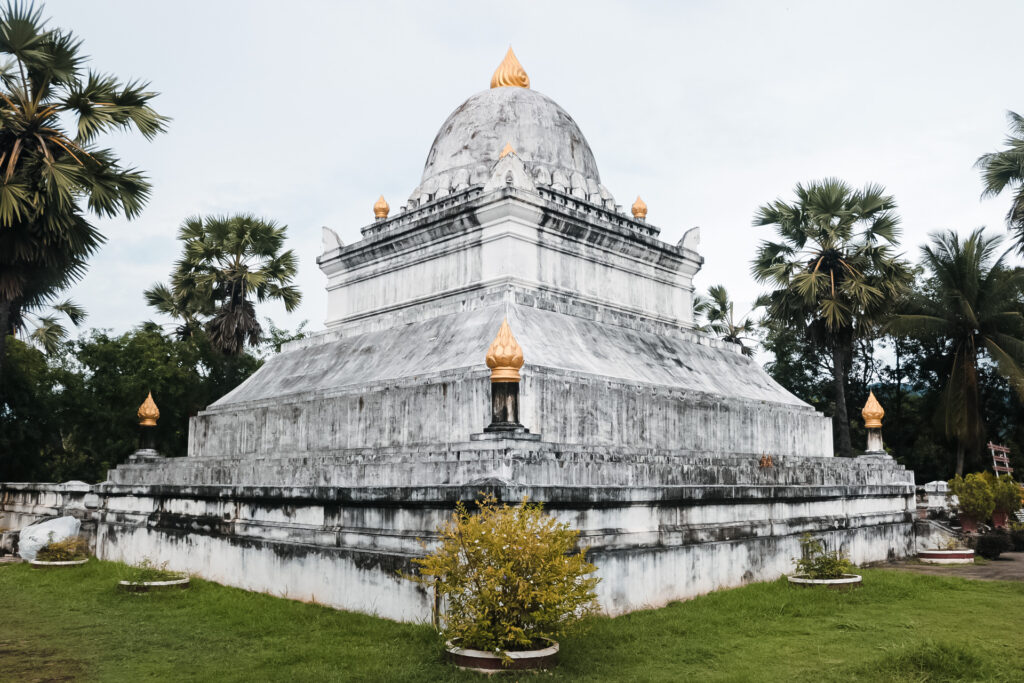
Then I left the temple and continued to walk around. I liked Luang Prabang much more than all the other towns I had already seen in Laos. But this is probably due to the French influence in Luang Prabang and the many cute cafes.
I then stopped at Wat Manorom and took a look at it too. Both temples I saw were pretty nice but not super special. From Wat Manorom, I made my way back towards the hostel. On the way I stopped at a bakery that sells smoothies. There I bought a smoothie, which was significantly more expensive than I was used to in Laos, and then went back to the hostel.
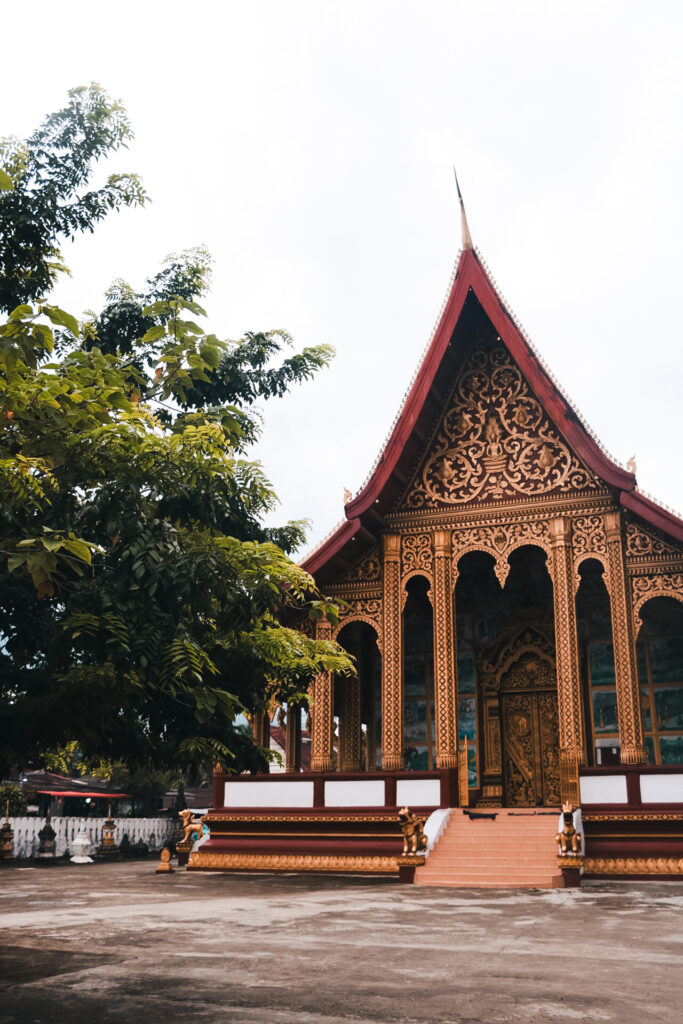
There I drank my smoothie and sat and chatted with a few people. Later I went to eat with a German guy at an Italian restaurant right next to the hostel. I had previously looked for the cheapest possible restaurant in Luang Prabang, but everything here is more expensive. I ended up paying 100,000 kip (around €5) for my dinner. Compared to Europe and other western countries, this is still cheap. But in Laos I’m used to paying a third of that price for my meals.
On the way to the famous Kuang Si Waterfall
The next morning I slept a little longer than usual. After getting up, I got ready and then went to the Morning Market where I wanted to buy some fruits. On the way back I looked for a cheap cafe or restaurant where I could have breakfast. But most cafés have not changed anything in terms of price. Finally I went to a café that was close to the hostel.
After breakfast I rented a scooter and set off to explore the surroundings of Luang Prabang. My first stop was to be the famous Kuang Si Waterfall. The waterfall was just outside of Luang Prabang and the drive there would take a while. I had previously asked several people in the hostel what the road to get there was supposed to be but this one should be quite good.
It didn’t rain all morning, just fairly cloudy. Just as I drove off, it started raining. So I turned around and drove back to the hostel. I waited a bit and fortunately it stopped raining very quickly. So I got back on my scooter and drove off. The road was actually very good. There were a few potholes from time to time but that was about it. The road was just quite curvy, so it took me a little while to get to the Kuang Si Waterfall.
Exploring the Kuang Si Waterfall in the pouring rain
The moment I parked my scooter, it started raining. I sheltered at the ticket office and waited for it to stop. An hour later it was still pouring rain. I then decided that there was no point in waiting any longer, so I bought a ticket to the waterfall and then I was taken to the waterfall in a small car along with other tourists.
But we still had to walk the last few meters. Because it didn’t stop raining, I got pretty wet very quickly. I actually had high expectations of the waterfall because it looked so incredibly beautiful in the pictures. In the end it was extremely touristy, everyone was busy taking a picture of themselves and the waterfall. In addition, the water was not turquoise blue, but brown. Of course, the pouring rain was extremely annoying. I was a bit disappointed by the waterfall.
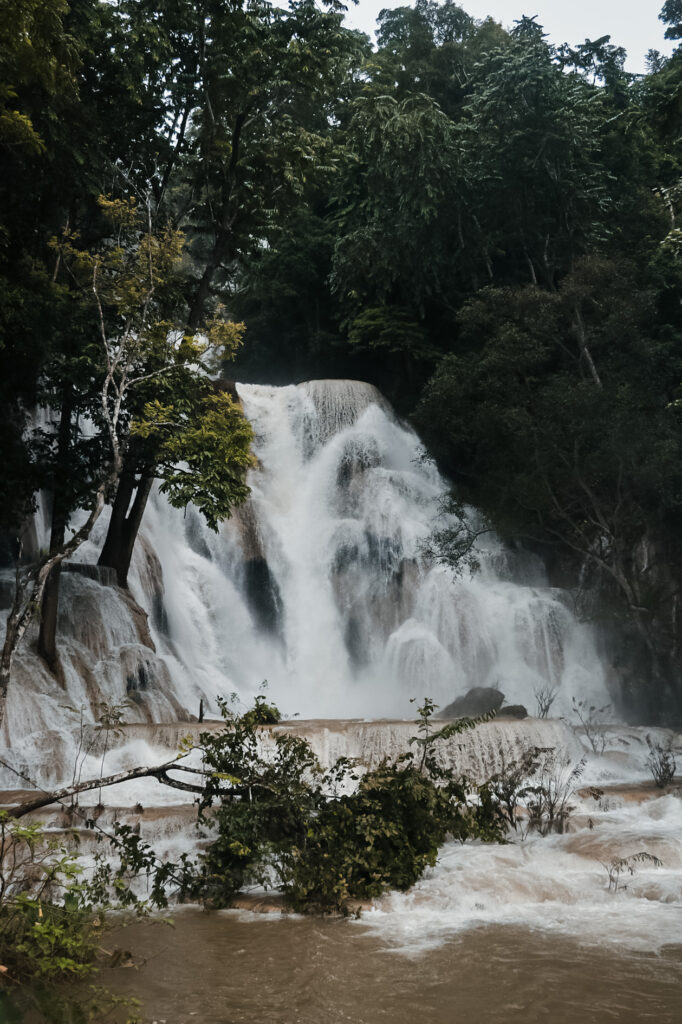
I didn’t stay there very long and drove the car back to the ticket office. It was still raining, but I didn’t want to wait any longer until it stopped. So I made my way back in the rain. Luckily it stopped raining pretty quickly.
Trying Buffalo Ice Cream on the way back
There was a Buffalo Diary not far from the waterfall. There I stopped and tried some ice cream made from Buffalo milk. I talked to the seller and it quickly became apparent that he was German, doing volunteer work with his girlfriend on the farm for five weeks. I asked the two of them what their duties on the farm were and they also told me, among other things, that they offer tours of the farm.
Then I decided to do a tour like this. Since I had already worked on a diary farm in Australia, I was interested in what the work on the Buffalo Farm in Laos looks like. Since nobody was there at that time who wanted to do this tour, I got a private tour of the farm and it was also in German.

The story behind the Buffalo Dairy
Four friends from Australia and the US were on a trip through Sri Lanka a few years ago where they tried Buffallo yogurt. They liked it so much that they wanted to produce their own products made from Buffalo milk. Laos, a country where there were many buffaloes, was therefore quite suitable. However, it quickly became clear that there was not a single Buffalo Diary in Laos.
In addition, it was not at all easy to make products from Buffalo milk, as this milk has a different texture to cow’s milk and recipes with cow’s milk were therefore not suitable. Over time, the idea developed into an entire business. Today, the only Buffalo Dairy in Laos offers tours of the farm and sells its products.
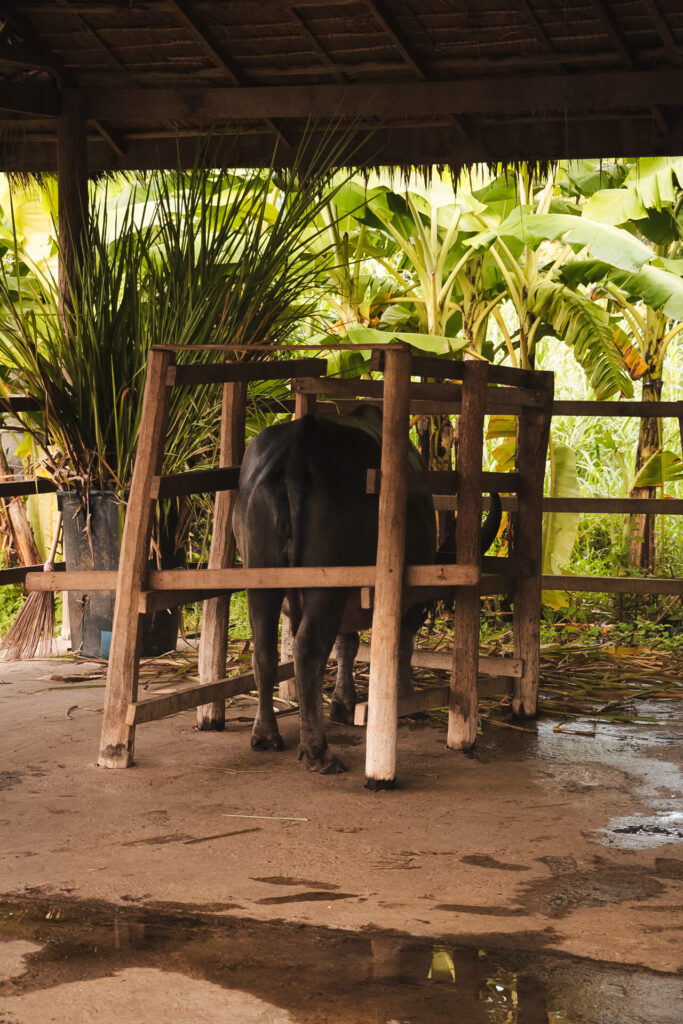
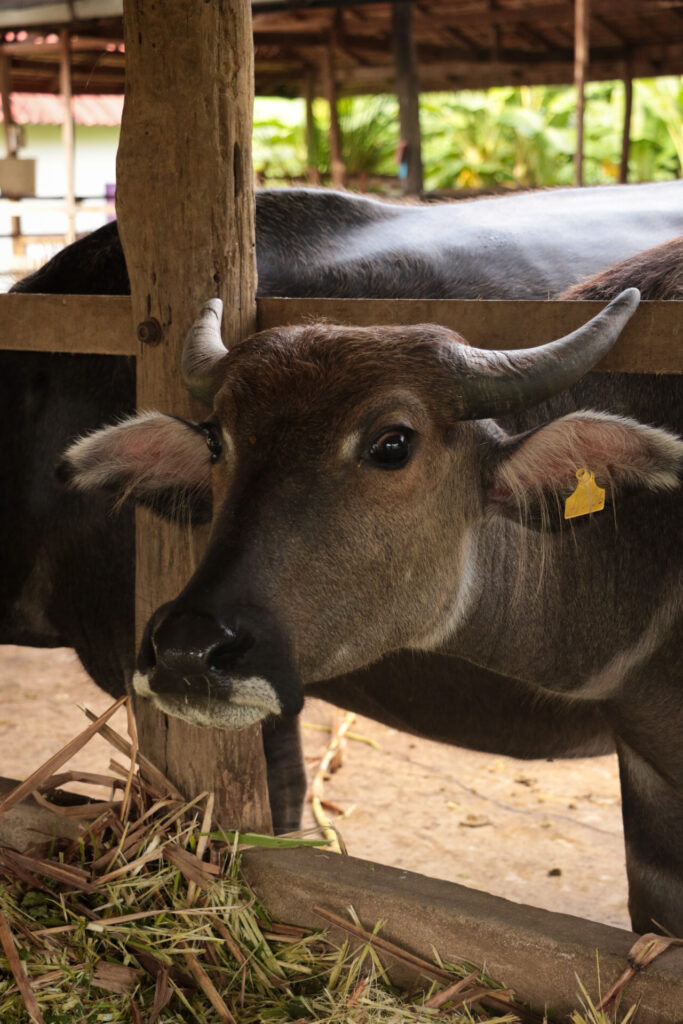
What’s happening at the Buffalo Dairy?
The buffaloes at the Buffalo Dairy are rented from local farmers for a few months while they give milk. They are then vaccinated and cared for on the farm.
Overnight the buffalo are separated from their children. The buffalo’s milk produced overnight is then milked the next day. Mother and child then come together again during the day so that the child gets the mother’s fresh milk again.
After a few months, when the buffalo stops giving milk, it goes back to the farmers. Since buffaloes produce much less milk than cows and are only milked once a day, products made from buffalo milk are of course much more expensive. For example, a kilo of cheese costs $80 USD. On the other hand, the animals are treated much better than on any large farm where cows are milked.
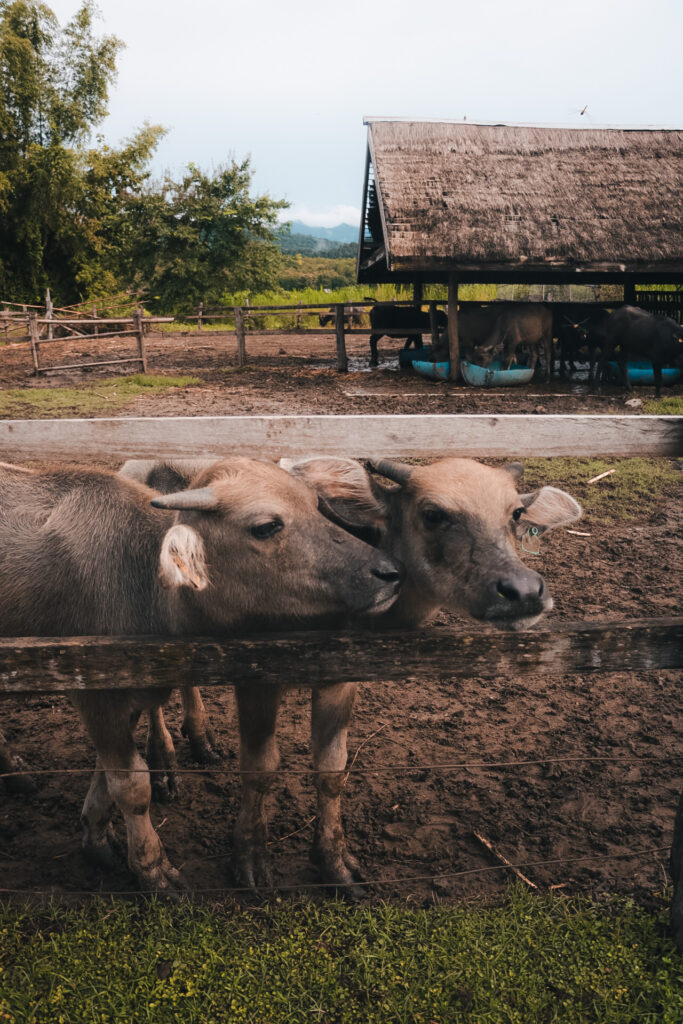
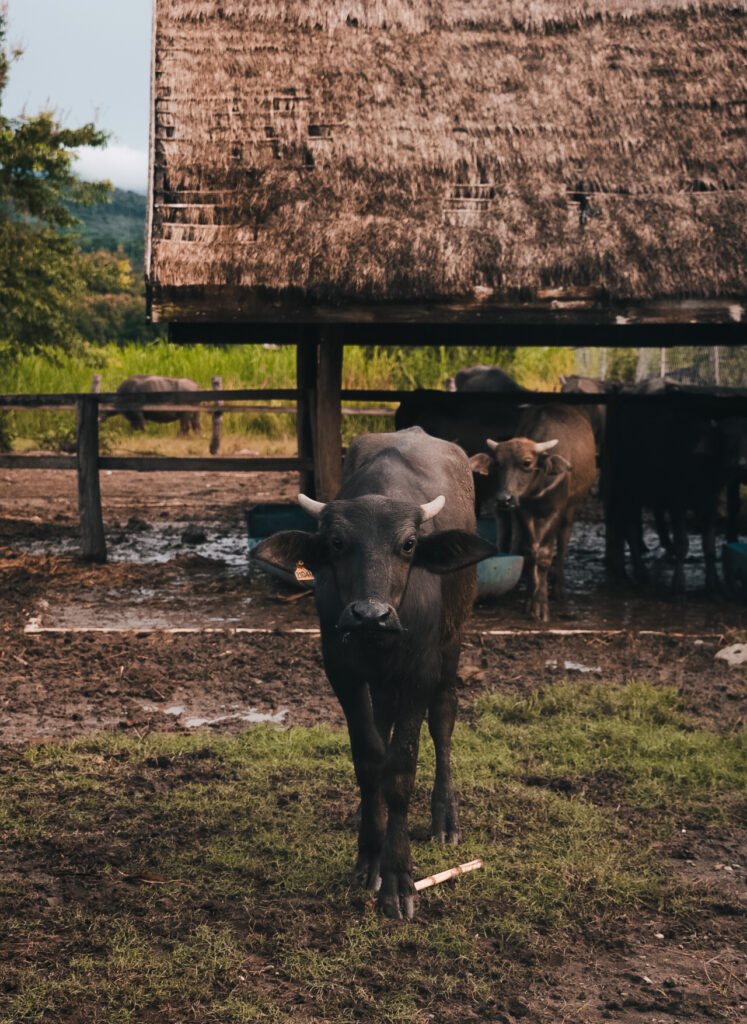
About the rabbits on the dairy
In addition to the buffaloes, rabbits are also kept on the farm. They are kept there like pets. They are also vaccinated and cared for. The rabbits are vaccinated by the local medicine students. Since the resources in Laos are fewer than in Europe, the students only learn a lot in theory. By vaccinating the rabbits they have the opportunity to learn this in practice.
About the pigs on the dairy
There are also pigs on the farm. In contrast to other pigsties, this one didn’t smell and the pigs were very clean. This was because a certain hay is used, which is also suitable for fertilization.
The water the pigs drink comes from a hose. There they can suck and drink. This way no water is wasted. If the pigs had a bucket or something similar to drink from, they would wash themselves in it, contaminate the water and then get sick. What I found most remarkable is that they only showed this drinking technique to one pig, and then that pig showed it to all the other pigs.
Watching the sunset over the River
After the Buffalo Farm tour, I drove back to Luang Prabang. By now the sun was shining and I was able to really enjoy the drive through nature. Since it was just before sunset, I decided to stop at a restaurant on the Mekong River and watch the sunset there. I found a nice restaurant by the river, ordered a drink and sat on the terrace with it while I waited for the sun to go down.

After sunset I finally drove back to the hostel. I had heard of a restaurant nearby that was pretty cheap. I then had dinner there.
Another day, another terrible road
The next morning I got up early again. It was cloudy but luckily it didn’t rain. Then I went back to the gym. When I came back I had breakfast in the café next to my hostel. It wasn’t Asian at all, but it was really nice. It reminded me a bit of my time in Australia, where I worked in a coffee shop.
After breakfast I went to another waterfall. Luckily the journey there didn’t take as long as it had the day before. However, the last kilometer to the waterfall was again a gravel road with lots of stones, puddles and mud. I drove down the street for a bit, but I didn’t really feel comfortable with my scooter. Finally I found myself in front of a large puddle that I had no idea how to get through. So I decided that this time the waterfall is not worth it to me, since it is probably not blue but brown. So I turned around again and drove the 20 kilometers back to Luang Prabang without seeing the waterfall.
The Historical Quarter of Luang Prabang
When I got back to Luang Prabang, it was only one o’clock in the afternoon, but there wasn’t really much left for me to do in the city. So I spent the afternoon doing some shopping and exploring the Historical Quarter of Luang Prabang.
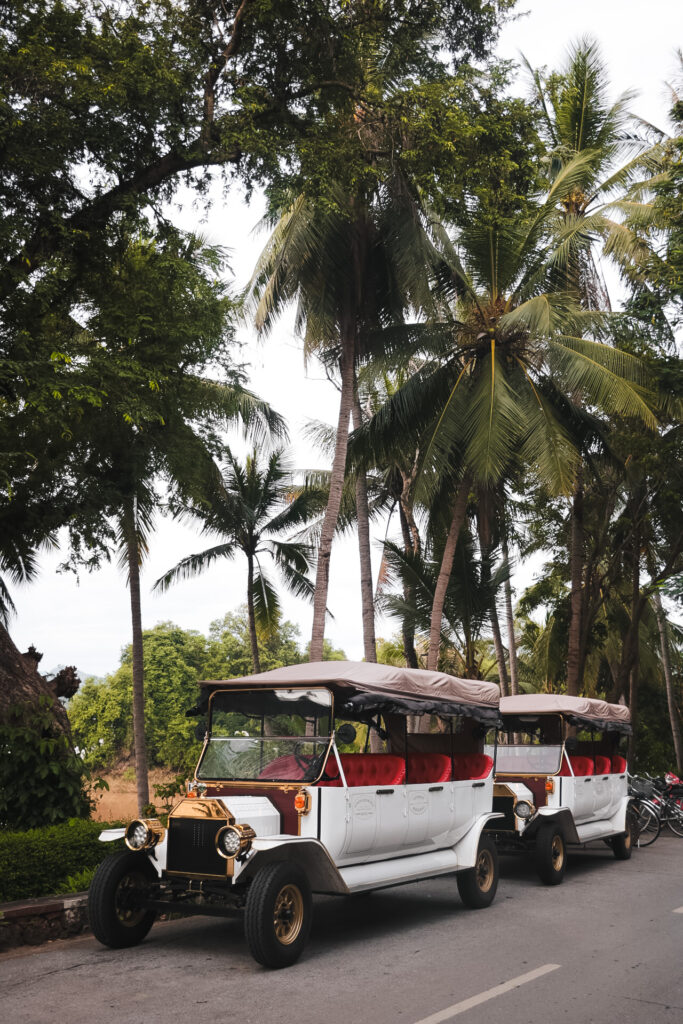

I really liked the Historical Quarter. The many cute houses with French influence right on the River also reminded me a little of Hoi An in Vietnam. It was also a big contrast to the places I already saw in Laos.
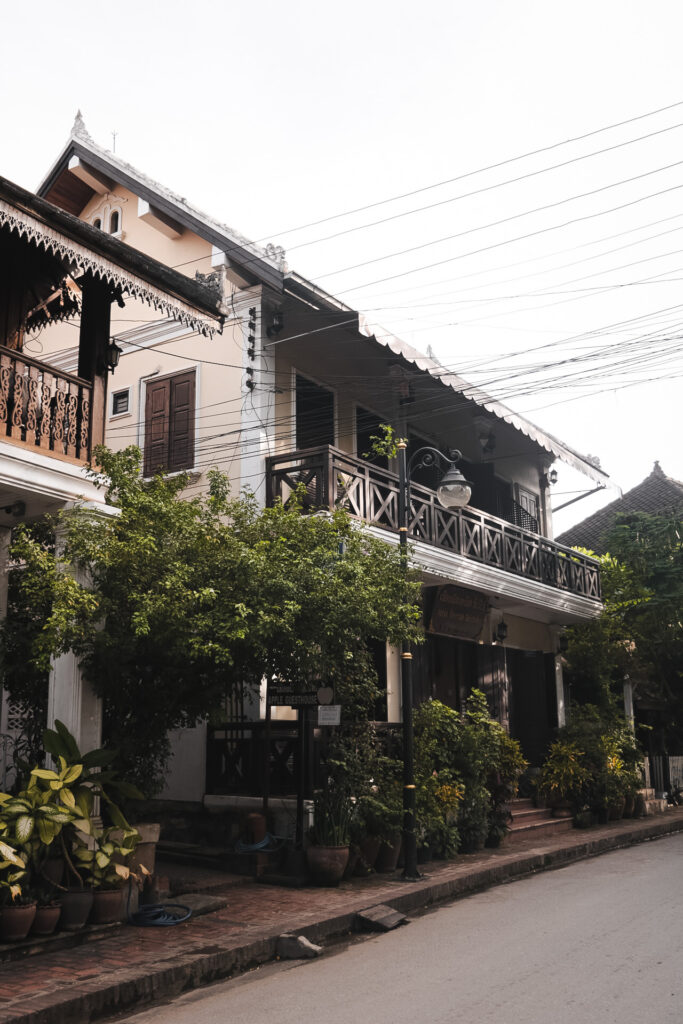

In the evening just before sunset I went to Mount Phousi. You can see the sunset very well from the viewpoint at the top. The ascent was exhausting, but after 10 minutes I was already up the many stairs and had a really nice view over Luang Prabang, the River and the sunset. Unfortunately it was a very touristy. I then waited for the sunset and then made my way back down before everyone did.
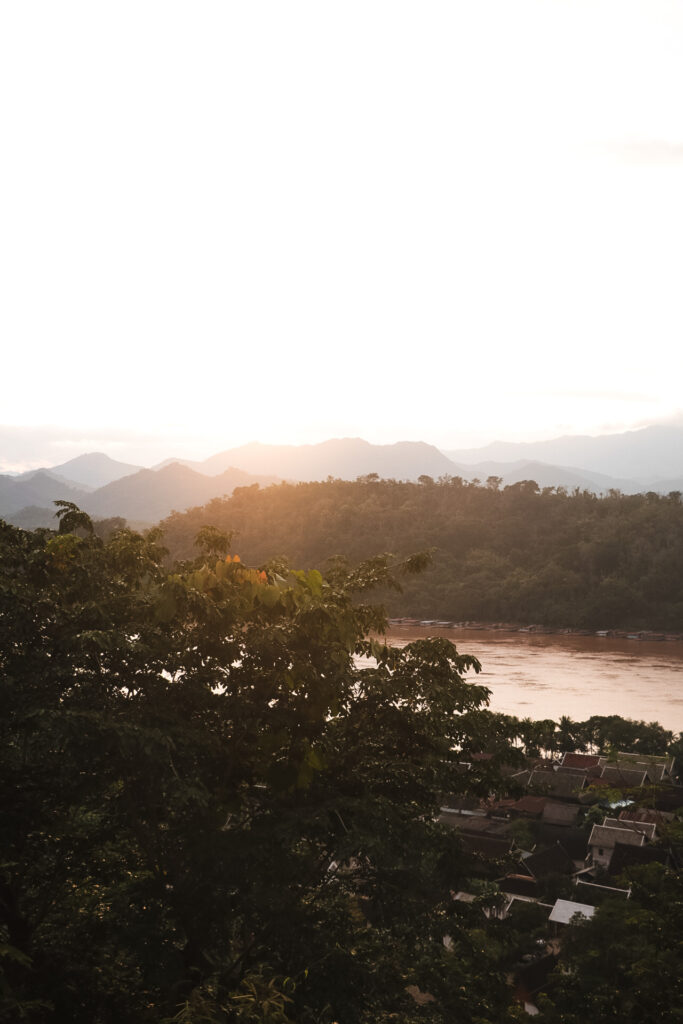
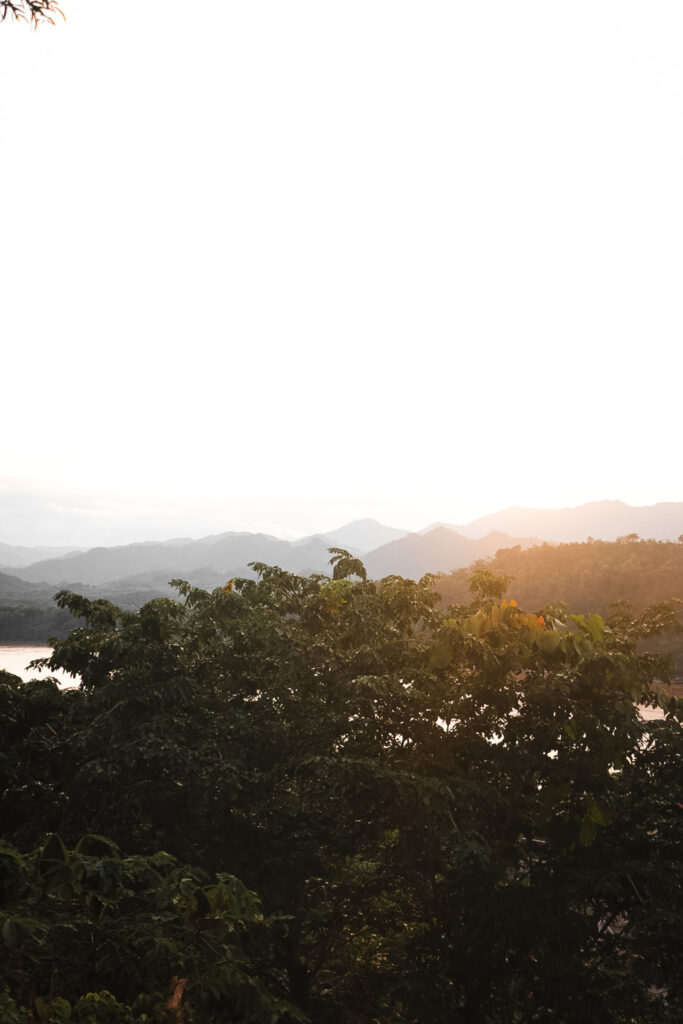
Back at the hostel, I booked my bus to Nong Khiaw for the next day. Then I packed my things and went to dinner. I went back to the Italian restaurant I had been to two days before. The cheap restaurant I was in the evening before was unfortunately closed on Sundays. That evening I tried a Pad Lao, which was very similar to a Pad Thai.
Learning more about Laos history in the UXO Visitor Center
My bus the next morning left at 10 am. Since I really wanted to visit the UXO Laos Visitor Center, I got up early again and drove there before breakfast. I would have visited the visitor center earlier, but it was closed over the weekend I was in Luang Prabang. The UXO Lao Visitor Center was opened in 2009 to educate people about unexploded ordnance (UXO).
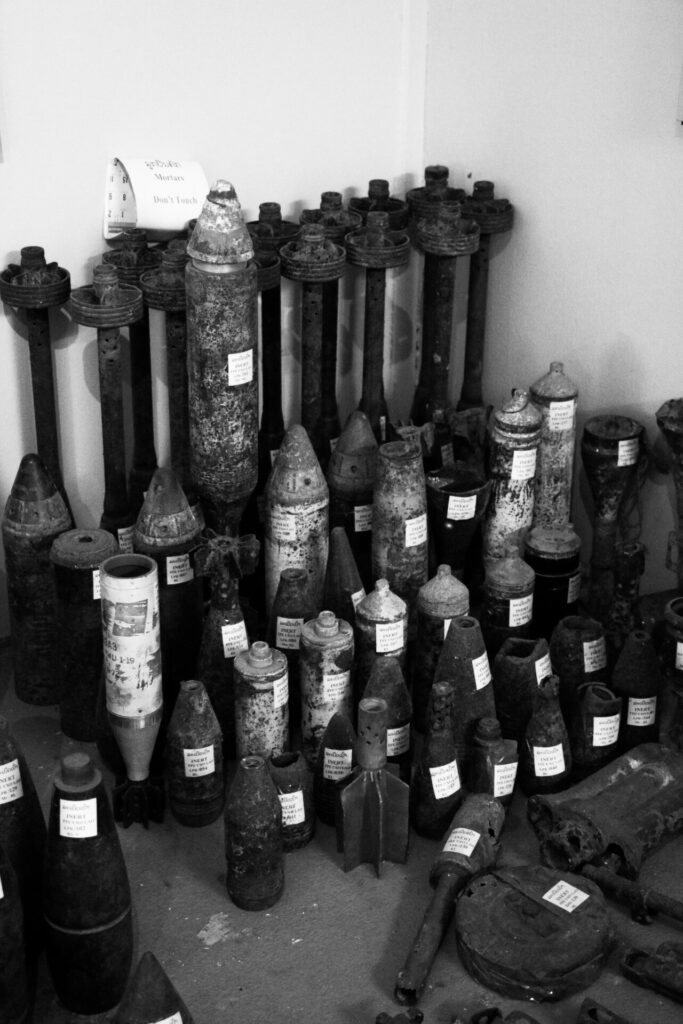

What are UXO?
Unexploded ordnance are explosive weapons that did not detonate when they were deployed during the wars in the 20th century and still pose the risk of exploding. UXO still kill and maim people as they go about their daily lives and will continue for a lot more years.
What is UXO Lao?
UXO Lao is a government run which clears UXO and educates the community of UXO dangers. The organization has a humanitarian mandate to reduce death and injury and open up land for agriculture production and other socio-economic development. In a year UXO Lao removes and destroys around 77 000 items of UXO.
Life with UXO
One person is killed or injured by UXO almost every two weeks in Laos. The fear of UXO in villages and fields can stop people using land for agriculture, reducing their ability to feed their families and earn a living. Therefore poverty is directly linked to the presence of UXO in an area.
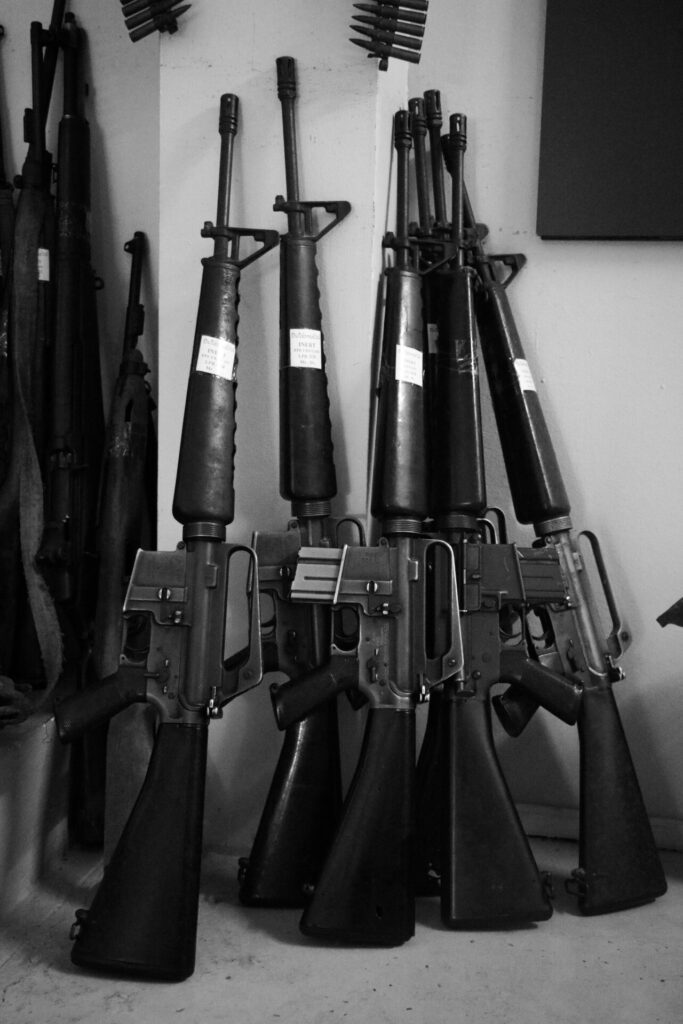

Wars in Laos
During the 20th century, Laos was embroiled in conflict; it is the remnants of these battles which haunt the people in Laos today in the form of UXO.
French Indochina War and Civil war
Laos was a French protectorate from 1893 – 1949. During world war 2 it was briefly occupied by the Japanese. Laos became involved in the regional fight for independence, known as the French Indochina war.
Throughout this period and the years to follow, ground munitions were used extensively through Laos, many remnants continuing to pose a risk to civilians today.
The Vietnam war
After the Indochina War, Laos became entangled in the Vietnam War (Second Indochina War).
Laos became a battlefield in the war between the US and North Vietnam.
During the war, US forces flew more than 500 000 bombing runs over Laos. More that 2 million tons of explosive ordnance were dropped on Laos. It is estimated that as many as 80 million bombies failed to explode. The massive aerial bombing raids flown over Laos during the conflict were responsible for most of the UXO in Laos today.
Visiting the visitor center was extremely interesting and once again I was able to learn a lot about the country and its history. After visiting the visitor center, I drove back to the hostel and gave my scooter back. After that I checked out and went to have breakfast. At 10 am. my bus left for Nong Khiaw.
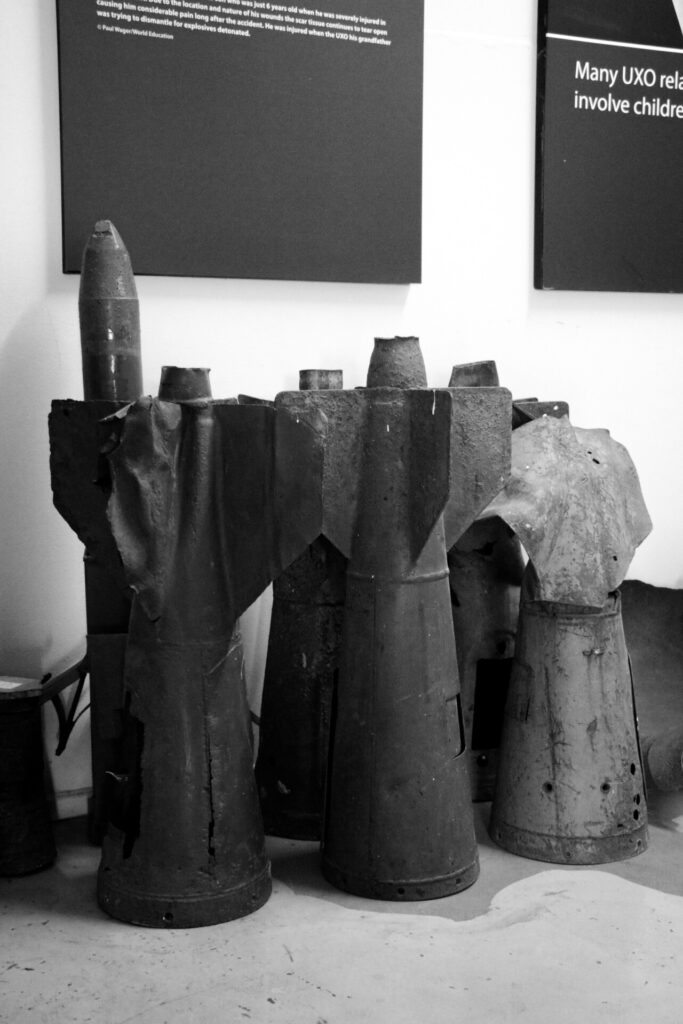
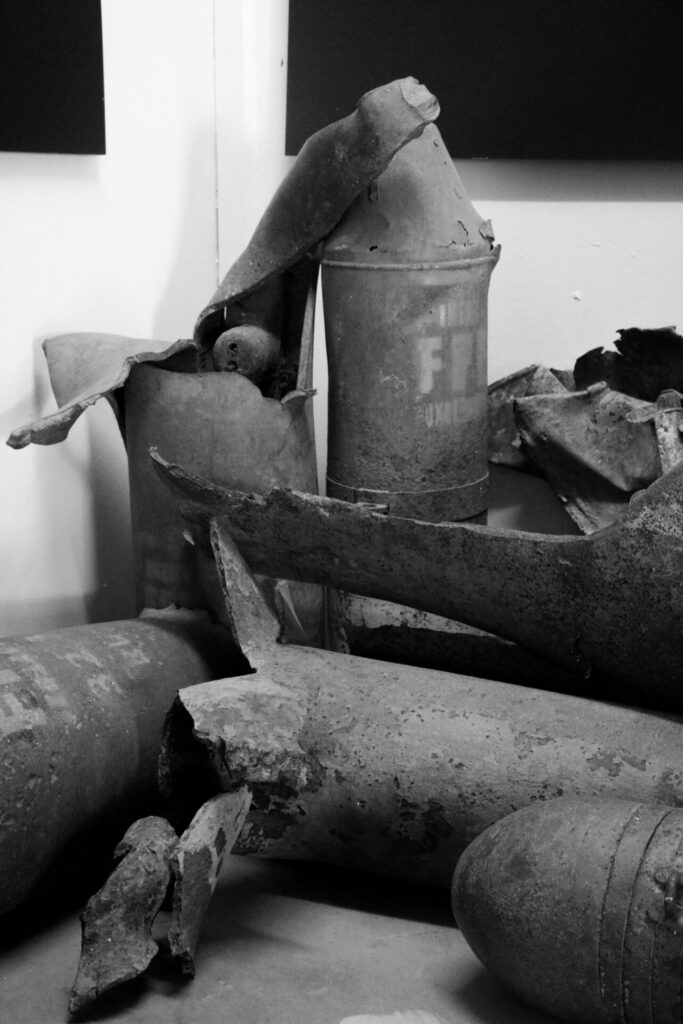
If you would like to know what I experienced during my time in Nong Khiaw, please read my next blog post Going on a trekking tour in Nong Khiaw – Laos Travel Diary.
